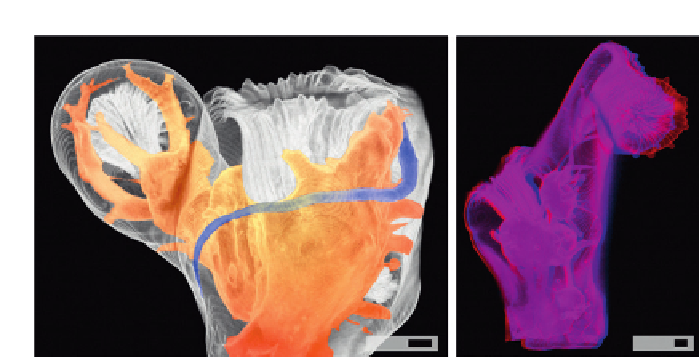Environmental Engineering Reference
In-Depth Information
A
B
1 mm
1 mm
FIGURE 3
Micro-CTscans of the cold-water coral
Lopheliapertusa
attacked
syn vivo
bya bioeroding
sponge (courtesyofLydiaBeuck). (A)Colored semitransparent visualizationof corallitewith the sponge
cavity (orange) and an embedded epibionticworm(blue). (B) Anaglyph3Dvisualizationof another cor-
allite with heavy sponge infestation (requires anaglyph glasses with left eye red and right eye blue).
3. MICROBIOERODING BIOTA AND THEIR TRACES
In the following account, a brief overview on the physiology, ecology, system-
atics, and fossil record of the main agents of microbioerosion is given and rel-
evant key ichnotaxa for each group are illustrated by SEM images of vacuum
epoxy resin casts.
3.1 Cyanobacteria
The majority of cyanobacteria are obligate photoautotrophs but facultative
photoheterotrophy and even chemoheterotrophy have been reported for certain
species (e.g.,
May and Perkins, 1979
). Facultative heterotrophy is discussed, for
instance, for the endolithic
Plectonema terebrans
which, as a particularly low-
light specialist, copes with dysphotic conditions (deepest record in 370 m water
depth;
Lukas, 1978
). Endolithic cyanobacteria reproduce by means of varying
vegetative strategies and are most active in the supratidal to upper subtidal
range (
Radtke et al., 1996; Schneider and Le Campion-Alsumard, 1999
). They
seek shelter from grazers in calcareous substrates, which they penetrate by
chemical means via carbonic acid formed from metabolic CO
2
(
Schneider,
1976
) or the support of endosymbiotic bacteria (
Lukas and Golubic, 1981
). Fur-
ther, biogeochemically more favorable modes of boring have been proposed in
the form of a temporal or spatial separation of photosynthesis and boring activ-
ity or a “calcium pump” in the sense of an extrusion of calcium ions through an
active cellular uptake and transport process (
Garcia-Pichel, 2006
).
An endolithic mode of life is common in the cyanobacteria with the most
characteristic representatives being found in the genera
Hyella
,
Solentia
,
Mastigocoleus,
and
Plectonema
and corresponding ichnospecies are found
within the ichnogenera
Fascichnus
(
Fig. 4
A-D),
Planobola
,
Eurygonum
(
Fig. 4
E), and
Scolecia
(
Fig. 4
F).






Search WWH ::

Custom Search